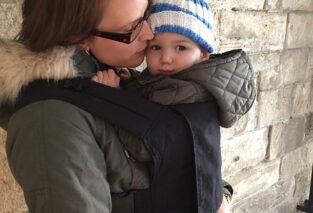In this article, we’ll explore the fascinating world of baby sign language and how it can enhance communication between you and your little one. By learning a few basic signs, you’ll be able to understand your baby’s needs and wants before they can even form words. We’ll discuss the benefits of using baby sign language, share some useful signs to get you started, and provide tips on how to incorporate signing into your daily routine. So, get ready to embark on this exciting journey of enhancing communication with your baby through the art of baby sign language.

What is Baby Sign Language?
Baby sign language is a form of communication that allows babies and their caregivers to communicate using simple gestures or signs. It involves teaching babies basic signs for common words and phrases, enabling them to express their needs, wants, and thoughts before they are able to verbally communicate. Baby sign language is a powerful tool that can bridge the communication gap between babies and adults, providing a means for them to effectively communicate and understand each other.
Benefits of Baby Sign Language
Using baby sign language has numerous benefits for both babies and their caregivers. Firstly, it reduces frustration and tantrums in babies who are not yet able to vocalize their needs. By being able to communicate their desires through signs, they feel understood and can express themselves more effectively.
Secondly, baby sign language promotes early language development. It enhances a baby’s cognitive and linguistic skills, as they learn to associate signs with words, concepts, and actions. Research has shown that babies who use sign language have larger vocabularies, exhibit better language comprehension, and demonstrate improved cognitive abilities compared to their non-signing peers.
Moreover, baby sign language strengthens the parent-child bond. It fosters a deeper sense of understanding and connection between the caregiver and the baby, as they engage in meaningful communication and share in each other’s experiences. By being able to communicate with signs, parents feel more empowered and confident in meeting their baby’s needs.
How Baby Sign Language Works
Baby sign language works by teaching babies simple and practical signs that represent common words and concepts. These signs are typically based on American Sign Language (ASL) but can also be modified or simplified to make them easier for babies to imitate.
When introducing signs to babies, caregivers should begin with a few basic signs that are relevant to the baby’s daily routines and activities. These signs can include words like “eat,” “milk,” “more,” “all done,” “diaper change,” and “mommy” and “daddy.” These signs are ones that the baby is likely to encounter frequently throughout their day.
To teach a sign, the caregiver should first say the word out loud while making the corresponding sign. For example, when saying “eat,” the caregiver can make the sign by bringing their fingers to their mouth as if they were feeding themselves. Repetition and consistency are key to the learning process, so the caregiver should reinforce the sign by using it consistently whenever the associated word is mentioned.
Common Signs to Use
Here are some common signs that are widely used in baby sign language:
- Eat: Bring the fingers of your dominant hand to your mouth, as if bringing food to your lips.
- Milk: Open and close your hand, mimicking the motion of milking a cow.
- More: Tap the tips of your fingers together a few times to indicate the desire for more of something.
- All Done: Extend both hands in front of you and turn them palms down, as if pushing something away.
- Diaper Change: Touch your fingertips to your diaper area and then motion as if wiping from front to back.
- Mommy: Touch your thumb to your chin and move it forward towards your chest.
- Daddy: Touch your thumb to your forehead and move it forward as you would when indicating someone’s forehead.
When to Start Baby Sign Language?
Age to Begin Sign Language
Babies can start learning sign language as early as six months old. At this age, babies have developed enough motor skills to imitate simple gestures and are becoming more aware of their surroundings. It is important to note that infants may not be able to physically sign until they are around eight to ten months old, but they can begin to understand the meaning behind the signs and associate them with words.
Starting early allows babies to establish a strong foundation in sign language and helps them to naturally incorporate signs into their daily routines. However, it is never too late to begin teaching sign language to a baby. Even if a baby is older, they can still benefit from learning sign language and experience improved communication skills.
Signs to Start with
When starting with baby sign language, it is best to focus on signs that are relevant to the baby’s daily life and routines. This could include signs for basic needs such as “eat,” “drink,” and “sleep,” along with signs for common objects or people in their environment.
By starting with these foundational signs, caregivers can begin to establish a sign language routine and build their baby’s vocabulary. As the baby becomes more comfortable with signing and starts to understand the process, additional signs can be introduced gradually.

Teaching Baby Sign Language
Creating a Sign Language Routine
Consistency is key when teaching baby sign language. Establishing a daily routine that incorporates sign language can greatly enhance the learning process. Caregivers should consistently use signs during everyday activities such as feeding, changing diapers, and playing.
For example, during mealtime, the caregiver can use signs for “eat,” “drink,” and “more” while speaking the corresponding words. By consistently using signs in these situations, the baby will begin to associate the signs with their meanings.
Encouraging Engagement and Practice
Engaging the baby in sign language activities and play can make learning more enjoyable and effective. Using toys, books, and songs that incorporate signs can help reinforce the learning process and make it more interactive.
One way to encourage practice is to make signing a part of playtime. For example, caregivers can introduce sign language while playing with toys, using signs like “ball,” “book,” or “play.” By incorporating signs into play, they can create a fun and engaging environment that encourages the baby’s participation and learning.
Using Visual and Verbal Cues
When teaching sign language, it is important to provide both visual and verbal cues. Caregivers should consistently demonstrate the sign while saying the corresponding word out loud. This dual reinforcement helps babies make the connection between the sign and the word.
Visual cues, such as pointing to objects while signing their names, can also help babies understand the meaning behind the sign. By associating the sign with the physical object, babies can begin to comprehend the purpose and relevance of the sign.
Common Challenges in Baby Sign Language
Resistance to Sign Language
Some babies may initially resist or show disinterest in learning sign language. This is normal and should not discourage caregivers from continuing their efforts. It is important to be patient and persistent, as babies may need time to adjust to the new form of communication.
To overcome resistance, caregivers can try to make sign language more engaging and interactive. Incorporating signs into playtime, singing songs that include signs, and using animated facial expressions while signing can help capture the baby’s attention and make learning more enjoyable.
Signs Misinterpretation
It is natural for babies to initially misinterpret signs or make their own variations. Caregivers should remain patient and understand that it takes time for babies to develop accuracy in signing.
To minimize confusion, caregivers should always stay consistent in their own signing and ensure that they are clear and expressive. Over time, as the baby becomes more familiar with sign language, they will develop a better understanding of the proper signs and their corresponding meanings.
Inconsistency in Signing
Consistency is crucial in teaching baby sign language. Caregivers should strive to use signs consistently, not just during designated signing sessions, but throughout their daily interactions with the baby.
Inconsistency in signing can create confusion for the baby and hinder the learning process. To maintain consistency, caregivers can create visual cues around the house, such as labeling objects with printed signs or using picture charts, to remind themselves and others to consistently reinforce the signs.

Tips for Effective Baby Sign Language
Keep It Simple
When teaching baby sign language, it is important to keep the signs simple and easy to imitate. Complex signs may be too challenging for babies to physically replicate, leading to frustration and discouraged learning.
Focus on teaching signs for essential words and concepts that are relevant to the baby’s daily routines. By starting with a small set of basic signs, caregivers can build a strong foundation and gradually introduce more signs as the baby progresses.
Be Consistent
Consistency is key when teaching baby sign language. Use signs consistently during daily interactions and routines to reinforce their meanings. This consistency helps babies understand that the signs have specific meanings and ensures that they are continuously exposed to the signs for reinforcement.
Caregivers should also strive to be consistent in their own signing style. Using the same handshape, movement, and facial expressions when signing a particular word helps babies recognize and associate the sign more effectively.
Use Positive Reinforcement
Praising and positively reinforcing a baby’s efforts in signing can greatly enhance their motivation and learning experience. Celebrate their attempts and successes by giving hugs, smiles, and positive verbal affirmations.
Consistently providing positive reinforcement creates a supportive and encouraging environment for the baby, motivating them to continue learning and practicing their signs.
Supporting Baby Sign Language at Home
Incorporating Signs into Everyday Activities
To reinforce the learning of sign language, caregivers can incorporate signs into their daily activities with the baby. During mealtime, diaper changes, bath time, and playtime, caregivers can use signs that are relevant to those specific activities.
For example, during mealtime, caregivers can consistently use signs like “eat,” “drink,” and “more,” along with the corresponding words. By consistently using signs in these situations, babies will begin to associate the signs with their meanings and make the connection between the sign and the action or object.
Promoting Language and Communication Skills
Baby sign language should not replace spoken language but rather complement it. Caregivers should continue to speak to the baby using clear and simple language while incorporating sign language.
By using signs in combination with verbal communication, caregivers are providing a rich language environment for the baby. This exposure to both signs and words strengthens the baby’s language development, enhances their vocabulary, and encourages them to use a variety of communication methods.

Incorporating Baby Sign Language with Speech
Transitioning from Signs to Spoken Language
As babies develop their speech and language skills, it is natural for them to transition from using signs to relying more on verbal communication. Caregivers can support this transition by gradually decreasing their use of signs while emphasizing spoken words.
During this transition, caregivers should continue to use signs for important words and concepts while introducing the corresponding spoken words. By consistently using both signs and words, caregivers help babies make the connection between the two and encourage the development of verbal language skills.
Combining Signs and Words
Even as babies transition to using spoken language, caregivers can continue to use signs as a visual aid to reinforce understanding and facilitate communication. By using signs alongside spoken words, caregivers provide multiple modes of communication, supporting visual learners and reinforcing comprehension.
For example, when introducing new words or concepts, the caregiver can simultaneously say the word while showing the corresponding sign. This multimodal approach helps babies make connections between signs, words, and their meanings, enhancing their overall language learning experience.
Baby Sign Language for Special Needs
Benefits for Children with Special Needs
Baby sign language can be particularly beneficial for children with special needs. It provides an alternative means of communication for those who may have difficulties with verbal language development.
For children with speech delays or language disorders, signing can offer a bridge between their thoughts and their ability to communicate them effectively. It reduces frustration and allows them to express their needs and desires, promoting a sense of independence and empowerment.
Moreover, baby sign language can be helpful for children with hearing impairments. By using sign language as a primary form of communication, these children can access language and interact with their caregivers effectively.
Adapting Signs for Special Needs
When teaching baby sign language to children with special needs, it may be necessary to adapt signs to match their abilities and limitations. Signs can be simplified or modified to better suit the child’s motor skills or specific learning challenges.
Caregivers can work with professionals, such as speech therapists or special education teachers, to identify and adapt signs based on the child’s individual needs. By tailoring the signs to the child’s abilities, caregivers can ensure that the child can successfully learn and use sign language as a form of communication.

Baby Sign Language in Early Education
Introducing Sign Language in Childcare Settings
Baby sign language is not limited to the home environment; it can also be introduced in childcare settings. Early education centers, daycare centers, and preschools can incorporate sign language into their curriculum to enhance communication and language development.
By teaching baby sign language in a group setting, children have the opportunity to communicate and interact with peers using signs. This fosters a sense of inclusivity and creates a supportive learning environment where children can reinforce their sign language skills together.
Educational Benefits of Baby Sign Language
The introduction of baby sign language in early education settings offers numerous educational benefits for young children. Learning sign language enhances children’s vocabulary development, fosters their cognitive abilities, and promotes their overall language and communication skills.
Incorporating sign language into the curriculum supports a multimodal learning experience, which has been shown to enhance cognitive processing and memory retention. By engaging children through visual and kinesthetic modes of learning, sign language enriches their educational journey and supports their overall development.
Conclusion
The art of baby sign language is a valuable tool that nurtures communication and understanding between babies and caregivers. By incorporating sign language into daily routines, caregivers provide babies with an effective means of expressing their needs, wants, and thoughts before they can speak.
Through consistent practice and positive reinforcement, babies develop their language and communication skills, promoting early language development and supporting their cognitive abilities. Baby sign language strengthens the bond between caregivers and babies, establishing a foundation of trust and understanding.
By integrating sign language into everyday activities, incorporating signs alongside spoken words, and adapting signs to meet the needs of children with special needs, caregivers can maximize the benefits of baby sign language. Whether used at home or in early education settings, baby sign language empowers babies to communicate their thoughts and feelings, enriching their overall development and fostering a lifelong love for language and communication.





